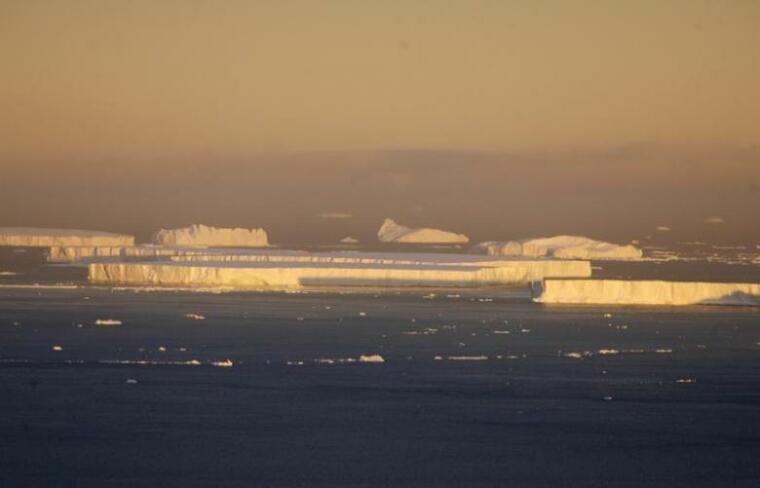Christian geologist says discovery of ancient tree stumps in Antarctica confirms Biblical flood account

A Christian geologist has argued that the recent discovery of fossilized tree stumps in Antarctica confirms the Bible's account of a global Flood.
Live Science reported last month that a team of scientists led by Erik Gulbranson, a paleoecologist at the University of Wisconsin-Milwaukee, had discovered a forest of fossil trees in Antarctica, which is said to be an indication that the climate was warmer there in the past.
While the researchers have not dated the forest precisely yet, they surmised that it flourished about 280 million years ago before it was rapidly buried in volcanic ash, which preserved it down to the cellular level.
However, Dr. Tim Clarey, a research associate at the Institute for Creation Research (ICR), contended that the fossilized trees are more consistent with the Biblical account of a global flood just thousands of years ago.
"This discovery should be no surprise to those who take Genesis as literal history. The Bible clearly describes a global Flood that affected all land masses—why should Antarctica be an exception?" he wrote in an article published on ICR's website.
Clarey explained that dinosaur and mosasaur (massive swimming reptiles) fossils are found on every continent including Antarctica, which he says suggests that a much warmer global climate existed before the Great Flood.
He further noted that some creationists have tried to explain the presence of temperate climate fossils in Antarctica by claiming that the Earth had "rolled" on its axis during the Flood, resulting in the North Pole shifting from central Asia to its present position.
But Clarey pointed out that the temperate and tropical-type flora and fauna fossils, like dinosaurs, can also be found in central China — which he said would have been the north pole if the earth indeed rolled on its axis.
He contended that the entire globe was warmer before the global Flood and that the forces that are required to explain the shift on the Earth's axis has not been resolved and remains a speculation.
Gulbranson, who specializes in geochemistry techniques, noted that the plants found in Antarctica were so well-preserved that some of the amino acid building blocks that made up the trees' proteins can still be extracted.
Clarey argued that the secular science community cannot provide a viable explanation for such discoveries.
"How could proteins and original amino acids survive for millions of years?" he asked. "These trees were buried rapidly during the global Flood described in Genesis. Temperate and tropical plants and animals were caught up and quickly buried in the ash, mud, and sand that engulfed them in this cataclysmic event. These fossils remind us that God's Word is true," he went on to say.
 Christians don't have to affirm transgenderism, but they can’t express that view at work: tribunal
Christians don't have to affirm transgenderism, but they can’t express that view at work: tribunal Archaeology discovery: Medieval Christian prayer beads found on Holy Island
Archaeology discovery: Medieval Christian prayer beads found on Holy Island Presbyterian Church in America votes to leave National Association of Evangelicals
Presbyterian Church in America votes to leave National Association of Evangelicals Over 50 killed in 'vile and satanic' attack at Nigerian church on Pentecost Sunday
Over 50 killed in 'vile and satanic' attack at Nigerian church on Pentecost Sunday Ukrainian Orthodox Church severs ties with Moscow over Patriarch Kirill's support for Putin's war
Ukrainian Orthodox Church severs ties with Moscow over Patriarch Kirill's support for Putin's war Islamic State kills 20 Nigerian Christians as revenge for US airstrike
Islamic State kills 20 Nigerian Christians as revenge for US airstrike Man who served 33 years in prison for murder leads inmates to Christ
Man who served 33 years in prison for murder leads inmates to Christ


 Nigerian student beaten to death, body burned over ‘blasphemous’ WhatsApp message
Nigerian student beaten to death, body burned over ‘blasphemous’ WhatsApp message 'A new low': World reacts after Hong Kong arrests 90-year-old Cardinal Joseph Zen
'A new low': World reacts after Hong Kong arrests 90-year-old Cardinal Joseph Zen Iran sentences Christian man to 10 years in prison for hosting house church worship gathering
Iran sentences Christian man to 10 years in prison for hosting house church worship gathering French Guyana: Pastor shot dead, church set on fire after meeting delegation of Evangelicals
French Guyana: Pastor shot dead, church set on fire after meeting delegation of Evangelicals ‘Talking Jesus’ report finds only 6% of UK adults identify as practicing Christians
‘Talking Jesus’ report finds only 6% of UK adults identify as practicing Christians Mission Eurasia ministry center blown up in Ukraine, hundreds of Bibles destroyed: 'God will provide'
Mission Eurasia ministry center blown up in Ukraine, hundreds of Bibles destroyed: 'God will provide' Church holds service for first time after ISIS desecrated it 8 years ago
Church holds service for first time after ISIS desecrated it 8 years ago Burger King apologizes for 'offensive campaign' using Jesus' words at the Last Supper
Burger King apologizes for 'offensive campaign' using Jesus' words at the Last Supper Uganda: Muslims abduct teacher, burn him inside mosque for praying in Christ’s name
Uganda: Muslims abduct teacher, burn him inside mosque for praying in Christ’s name